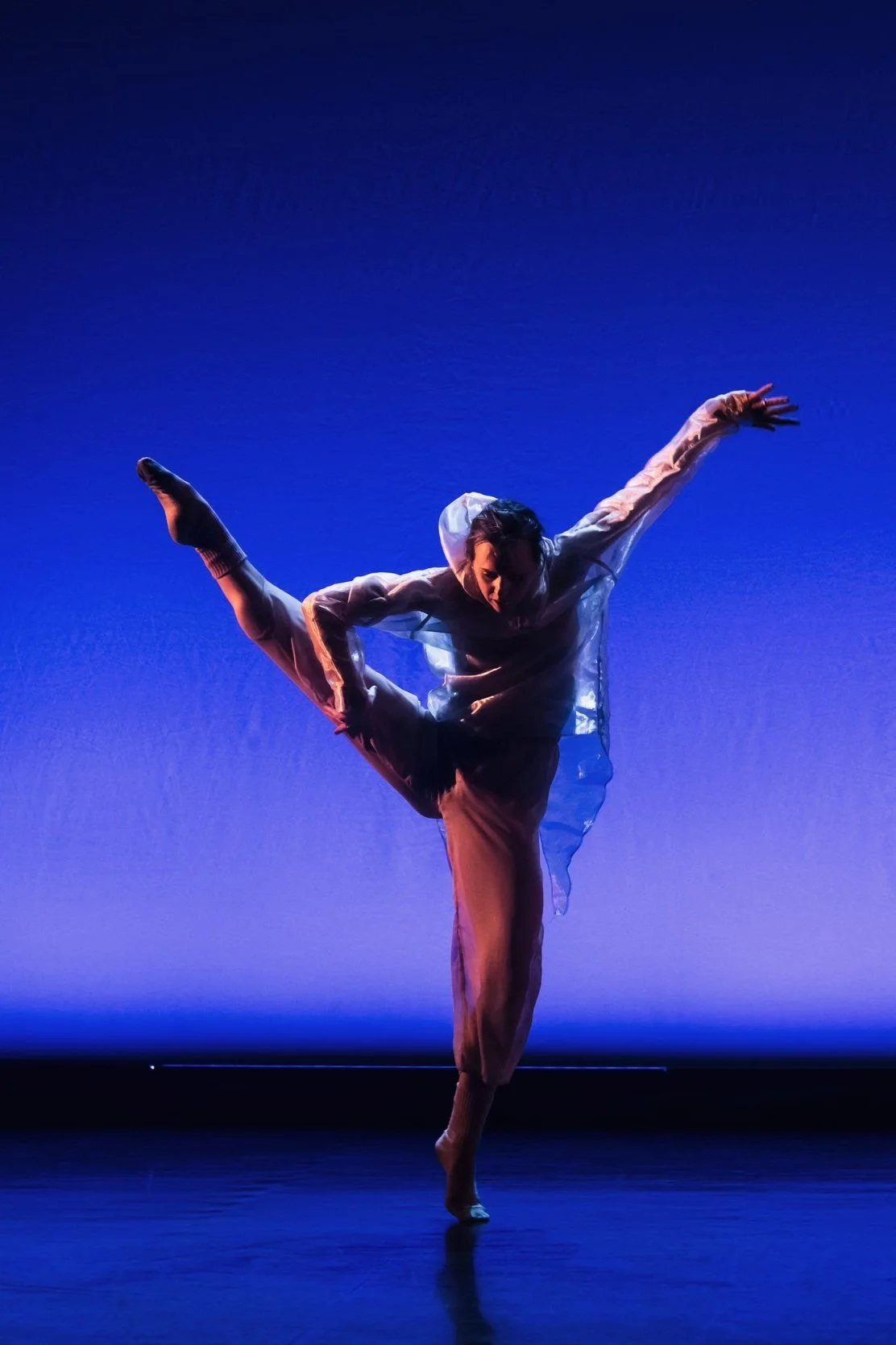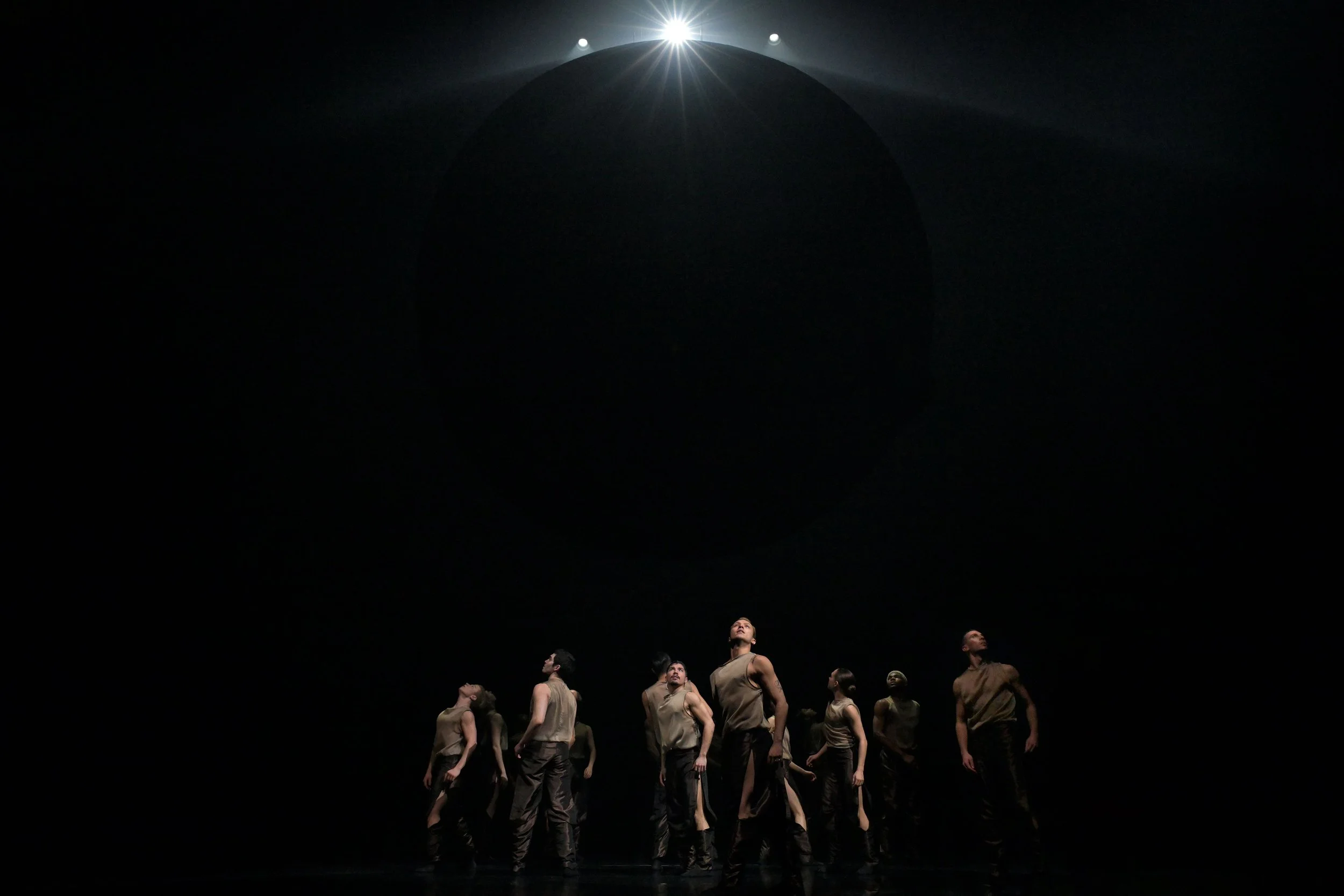Alexis Fletcher blends dance, poetry, and projections in meditation on memory and mortality
In assemble, a broken sail and layered coats are just some of the metaphorical images
In assemble, Alexis Fletcher dances in front of lighting and projections on a “broken sail”. Photo by Sylvain Senez
Alexis Fletcher presents assemble at the Scotiabank Dance Centre from January 13 to 15
OUTSIDE THE Scotiabank Dance Centre, where freezing rain is turning snowy sidewalks into a sea of slush, people are bundled up in their warmest parkas. But here, in the studio, Alexis Fletcher is removing thick layers of coats, one by one, while she bounces hypnotically up and down in place. A down puffer gives way to a trenchcoat, and then a suede jacket, a peacoat, a blazer. She discards them into a growing mountain on the floor.
It’s just one of the striking metaphorical sequences in her new solo, assemble. Watching her let go of the weight, little by little, allowing her to move more freely, resonates at a time when a momentous pandemic pause has forced everyone to reassess what is essential in a world.
“It’s the letting go of what you don't need so you can have more,” the artist, a former principal dancer and current artist-in-residence at Ballet BC, explains to Stir afterward.
She and her creative team conjure many other dreamlike images in assemble, a work in which the artist meditates on mortality and memory. Another striking one is a huge, broken-sail set piece that becomes a projection screen for the impressionistic video shot and edited by her partner in life and art, Sylvain Senez—also a Ballet BC alumnus. (He constructed the splintered sail.)
The allusion to a shipwreck came from the idea of an external force or natural disaster making you stop and reconsider your life, Fletcher explains. “Those are almost the times that precipitate an inward journey. It could be something catastrophic or just a wakeup call,” she clarifies. “We didn't want it to be too literal, but it was the idea of, ‘What would happen in the moment after the shipwreck? You've washed up on the shore and then you take stock of your life.’
“We also liked the shipwreck because it makes you think of a little voyage,” she adds. “Maybe you were travelling in time and space—and it’s more of a contemplative journey.”
Working with her husband, Fletcher is drawing on the vast and varied contemporary ballet she explored with Ballet BC, melding it with his audio-visual worlds, and driving it all with her own poetic writing.
Together, the pair are building a unique new voice in Vancouver’s vibrant dance scene. Last fall, they worked together on light in the rafters, a piece that used video to bring the paintings of Tiko Kerr to life onscreen while Fletcher dance live at the Chutzpah Festival. Long before that, Fletcher and Senez had presented outdoor site-specific summer performances, dubbed Dance Deck, at their East Van Home.
Photo by Jon McRae
“I don't think my work would be this cross-disciplinary without his sensibility in there,” Fletcher reflects of working with Senez, whose early interest in photography gave way to film. “We’re really feeding each other, and we both love the challenge of building things ourselves—building from the ground up.”
Still, Fletcher’s starting point as a choreographer is often writing. Even as a young dancer who had just arrived at Ballet BC from Arts Umbrella, she could always be seen with a pen and notebook, madly journalling to find her way through the dance. In the case of assemble, she continued her writing in the studio, right along with creating the movement. And that poetry now takes a prominent role in the work’s voice-over by her. (There’s also music by Dustin O’Halloran, Sigur Rós, and the show’s lighting designer Victoria Bell.)
“I was thinking a lot about memory,” she explains of the creative process. “For me, when I look back on things, I don't experience linear memory; it’s more in my cells—in flashbacks and in sensory ways, a smell or an emotion or a quick flash.”
The imagery (projections capture flowing water and opening doors) and words in the piece play out in a similar elliptical way. The inspirations for the free-verse poetry and movement are specific to Fletcher’s life, she says, but she prefers to keep those autobiographical roots to herself so the audience can relate in a more universal way to what her work is saying.
“I know what it means to me, but my hope in that context of the performance is that there’s something open-ended enough that they’ll recognize something for themselves,” she says. “We all look back and we all look forward. We’ll all lose someone that we love, and we’re all aware that all of this is finite.”
Similarly, though she created the work entirely under COVID lockdowns—and in many ways, working on the solo helped get her through that ordeal—she says, “I would never say it is about the pandemic.”
As for the movement language itself, Fletcher fills it with diverse stylistic touchstones and techniques—a result, she surmises, of her many years with Ballet BC, working with such a wide range of choreographers. Fletcher was always a deeply expressive standout at the Queen Elizabeth Theatre—you can feel her feel, right out to the tips of her gracefully extended fingers—and as a soloist she has no challenges holding the stage.
“I’m that way by nature: I just feel things more deeply,” the artist says with a laugh. “Dance has always been very much in my heart. It’s been my way of connecting with the world.
“A lot of the work I’ve had to do is to calibrate the amount of emotion I show, to have clarity. Never have I had a correction where I’ve had to feel more,” she adds with another laugh, explaining her writing brings her a kind of balance with dance. “But isn't it an amazing metaphor for being alive? The more I can verbalize, the more chill I can be inside of it.” And maybe that approach, and assemble itself, can help us all to be a little more chill amid the metaphorical shipwreck that is January 2022.















